The Neuroptera, also known as Planipennia, is one of the oldest insect orders with complete metamorphosis. With ~6000 species distributed among 17 families, the order is relatively small. It includes the green and brown lacewings, antlions, owlflies, dustywings, mantidflies, and allies. Its members occupy a wide variety of habitats and display an array of life styles. Because of their lacey and colorful wings, delicate bodies, and fascinating biology, neuropteran adults attract the attention of both biologists and laypersons (see Fig. 1).
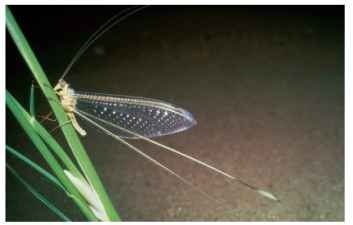
FIGURE 1 Neuropteran adult in the family Crocidae. Note the colorful forewings, long slender hind wings, and delicate body.
Neuropteran larvae are much less noticeable than adults and have received much less attention. Unlike the adults, which may or may not take prey, almost all neuropteran larvae are predacious. Several families (primarily Chrysopidae, Hemerobiidae, and Coniopterygidae) are useful in the natural, biological, and integrated control of many economically significant insect pests. But, despite their actual and potential importance, they have received less emphasis than other groups, such as the predacious lady beetles.
The name “Neuroptera”—from the Greek words “neuron” meaning “sinew, tendon” and “pteron” meaning “wing”—refers to the netlike arrangement of veins and cross veins in the wings. The term comes from an old usage of the word “nervation”, meaning “strengthening by sinews”. It did not refer to nerves, as often suggested.
CHARACTERISTICS
Neuropteran adults are soft-bodied and have four membranous wings of similar size, structure, and venation; the wings are held roof-like over the body while the insect is at rest (Fig. 2). Branches of the veins are generally bifurcated at the wing margins. Adults have chewing mouthparts, large compound eyes located laterally on the head, and multiarticulate antennae that are usually filiform (threadlike) or moniliform (with bead-like segments). Except for one family (Osmylidae), adults lack ocelli. The mesothorax and metathorax are similar in structure, and the cylindrical abdomen lacks cerci.
Neuropteran larvae differ markedly from adults. Larval mandibles and maxillae are usually elongate, slender, and modified for sucking; maxillary palpi are absent. The larval thorax bears walking legs, and the one-segmented tarsus usually ends in two claws that function in locomotion. The terminal adhesive disks of the abdomen also aid locomotion. Like the adult, the larva lacks abdominal cerci.
Neuropteran larvae spin silken cocoons within which they metamorphose. Pupae are decticous; that is, they have strong mandibles that are used to cut open the cocoon. After exiting from the cocoon, the exarate pupae are capable of limited locomotion before they molt to the adult stage; their legs and unexpanded wings are free from the body, and the abdomen is moveable.
Most Neuroptera studied have XX/XY sex determination. However, their sex chromosomes may display an unusual type of pairing (“distance pairing”), in which the chromosomes do not align to form bivalents during meiosis; rather, they are pulled from within

FIGURE 2 Adult Neuroptera: (A) Psychopsidae; (B) Myrmeleon-tidae; (C) Hemerobiidae; (D) Ascalaphidae; (E) Osmylidae; (F) Itho-nidae.
the spindle to stabilized positions at the poles. This form of meio-sis and other cytological features are shared with Raphidioptera. In many neuropteran taxa, meiosis occurs early in development, for example, during the last instar or the pupal stage. In these taxa, adult males have degenerate testes, and mature sperm bundles are stored within the seminal vesicles.
FOSSIL RECORD AND GEOGRAPHIC DISTRIBUTION
Although the fossil record of the Neuroptera is fragmentary, ancient (extinct) neuropterans have been traced back reliably to the Late Permian of Eurasia. The affinities of these archaic forms to modern taxa are undetermined; they seem to be a stem group. Other early neuropteran fossils appear in the mid-Mesozoic; these specimens, some of which are assigned to the extinct family Permithonidae, have a primitive wing structure and their affinities with modern neuropterans are unknown. The largest recorded neu-ropteran, a psychopsid-like lacewing (in the family Kalligrammatidae) with a wingspan of 24 cm and large conspicuous ” eyespots ” on the wings, existed in the Jurassic. Fossils from the Jurassic are also known for extant families from both suborders (Myrmeleontiformia: psychopsids, nymphids; Hemerobiiformia: polystoechotids, osmylids, chrysopids, hemerobiids, and coniopterygids). Cretaceous amber includes specimens from an array of modern families, including Berothidae, Mantispidae, and Osmylidae, among others, and the diverse Neuroptera found within Baltic amber (Eocene) can be placed within modern families.
Today, the order Neuroptera is distributed worldwide, except for Antarctica. Europe, North America, and Asia have rich neuropteran faunae as do southern Africa, South America, and Australia. Australia may have the broadest diversity; it lacks representatives from only two families (Dilaridae and Polystoechotidae) and most of the presumed archaic families are represented there (e.g., Nevrorthidae, Sisyridae, Ithonidae). In contrast, New Zealand and the South Pacific islands have only meager neuropteran faunae. Remarkably, Hawaii appears unique in being the only island group to have evolved complexes of endemic species (Hemerobiidae and Chrysopidae).
EVOLUTIONARY RELATIONSHIPS
WITH OTHER ORDERS
Taken together, the three orders, Megaloptera (dobsonflies, alderflies), Raphidioptera (snakeflies), and Neuroptera, (Neuroptera sensu stricto, Planipennia) (lacewings, antlions, dustywings, and allies) form the superorder Neuropterida. Because of its ancient fossil record, the generalized body structure of its larvae and adults, and its exarate pupae, Neuropterida is considered to be among the most primitive taxa within the Holometabola (insects with complete metamorphosis, Endopterygota). Significant morphological and molecular evidence indicates that this superorder is a monophyletic grouping and in a sister relationship with the Coleoptera.
A number of synapomorphic (shared, relatively derived or specialized) characteristics distinguish the Neuroptera as a mono-phyletic order that is separate from Megaloptera and Raphidioptera. Notably, most of these distinguishing features occur in the larvae. For example, megalopteran and raphidiopteran larvae have biting-chewing mouthparts, the mouth opens anteriorly, and the cervix has a single, unarticulated, ribbon-like sclerite. In contrast, the mouth-parts of neuropteran larvae are suctorial and consist of elongate and pointed mandibles and maxillae whose adjacent grooved surfaces form a feeding tube. The mouth, instead of opening anteriorly, connects to the feeding tubes at the sides of the head, and the larva has an articulated, neck-like cervix.
Other larval characteristics distinguish the Neuroptera from the other two neuropteridan orders. Neuropteran larvae do not have contiguous intestinal tracts. Rather, the midgut and hindgut remain separate until pupation. As the larvae feed, waste accumulates in the midgut. Only after metamorphosis, during which the midgut and hindgut become connected, do the newly emerged adults expel the feces as a meconial pellet. Neuropteran larvae use the hindgut and associated structures (Malphigian tubules) to produce silken cocoons in which the larvae metamorphose to exarate, decticous pupae. In contrast, megalopteran and raphidiopteran larvae have contiguous intestines, and they do not form cocoons or spin silk; rather, they metamorphose within earthen chambers or wooden cells. Like the Neuroptera, their pupae are exarate and decticous.
Recent phylogenetic studies have examined the relationships among the three neuropteridan orders; these studies used comparative data from male and female genital structures, larval cryptonephry (fusion of Malphigian tubules to the hindgut), larval head and mouth-part structure, and the molecular structure of several nuclear and mito-chondrial genes. Although not without limitations, the preponderance of current evidence indicates a dichotomy between Raphidioptera and (Megaloptera + Neuroptera) and a relatively well-supported sister relationship between Megaloptera and Neuroptera (Fig. 3).
EVOLUTIONARY RELATIONSHIPS WITHIN NEUROPTERA
The order Neuroptera encompasses 17 families that currently fall into 3 suborders: Nevrorthiformia, Myrmeleontiformia, and Hemerobiiformia. Two of the three suborders, Nevrorthiformia and Myrmeleontiformia, are well supported by morphological and molecular data, and current evidence indicates that an aquatic larval life style, typified by the Nevrorthiformia, was the primitive neuropteran condition (Fig. 3). However, the data are contradictory regarding the phylogenetic history of the two hemerobiiform families with aquatic/ semiaquatic larvae—the Sisyridae and Osmylidae. Current molecular evidence can be interpreted as consistent with the retention of a primitive aquatic state in these two families, whereas morphological data from the larvae are consistent with the secondary acquisition of aquatic/semiaquatic life styles. The debate continues.
Order Neuroptera ( = Neuroptera sensu stricto, Planipennia) Suborder Nevrorthiformia (= Neurorthiformia, a misspelling)
Family Nevrorthidae ( = Neurorthidae, amisspelling) (12 species) Suborder Myrmeleontiformia
Family Psychopsidae (silky lacewings) (—26 species) Family Nemopteridae (spoon-winged lacewings) ( — 100 species) Family Crocidae (thread-winged lacewings) (— 50 species) Family Nymphidae [including Myiodactylidae of some authors]
(split-footed lacewings) (—35 species) Family Myrmeleontidae [including Stilbopterygidae of some
authors] (antlions) (— 2,100 species) Family Ascalaphidae (owlflies) (—430 species) Suborder Hemerobiiformia
Family Ithonidae [including Rapismatidae of some authors]
(moth lacewings) (— 35 species) Family Polystoechotidae (giant lacewings) (4 species) Family Osmylidae ( — 160 species) Family Sisyridae (spongillaflies) (—50 species) Family Chrysopidae (green lacewings) ( — 1,200 species) Family Hemerobiidae (brown lacewings) (—550 species)
Family Coniopterygidae [including Brucheiseridae
of some authors] (dustywings) (—450 species) Family Dilaridae (pleasing lacewings) (—65 species) Family Mantispidae (mantidflies) (—400 species) Family Berothidae [including Rhachiberothidae of some authors]
(beaded lacewings) ( — 115 species)
SUBORDER NEVRORTHIFORMIA
The Nevrorthiformia contains a single, very small family, Nevror-thidae. This family shares several characteristics with the Megaloptera and is considered basal among the Neuroptera: for example, its aquatic larvae retain some megalopteran-like head structures (e.g., well-developed gula), and they have Malphigian tubules that lie free distally (i.e., without cryptonephry). Thus, the Nevrorthiformia emerges as the basal neuropteran suborder.
Among the Neuropterida, a terrestrial life style without crypton-ephry is considered plesiomorphic (primitive); this life style is typical of all Raphidiopterans. The evolution of an aquatic larva (without
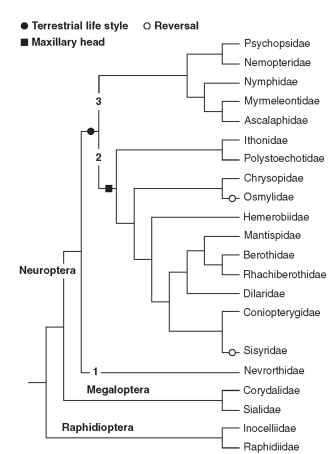
FIGURE 3 One of several cladograms depicting the phyloge-netic relationships within Neuropterida (modified from Haring and Aspock, 2004). Note the sister relationship between Neuroptera and Megaloptera, the separation of three neuropteran suborders, and the relationships of the families within the suborders. (1) Nevrorthiformia; (2) Hemerobiiformia; (3) Myrmeleontiformia. The black circle indicates the evolution of a terrestrial life style; the open circle indicates the evolutionary reversal from a terrestrial life style to an aquatic or semiaquatic one. A “maxillary” larval head is the major apomorphy that typifies the Hemerobiiformia.
cryptonephry) is considered a synapomorphy that may support a sister relationship between the megalopteran and neuropteran lineages. According to this interpretation, the aquatic life style (without crypton-ephry) was retained in the Nevrorthiformia, whereas a reversal to the terrestrial life style and the acquisition of cryptonephry (i.e., all but two Malphigian tubules are fused to the hindgut) characterize the remainder of the Neuroptera (the Myrmeleontiformia and Hemerobiiformia). The only exception is found in Sisyridae, which falls within the Hemerobiiformia; here, the partial expression of cryptonephry (all but one Malphigian tubule are free of the gut) may be regarded as an evolutionary reversal associated with the secondary evolution of an aquatic larva. The single remaining fused Malphigian tubule may be evidence of the ancestral cryptonephry. The semiaquatic Osmylus larvae are also unique; they have five fused and two free Malphigian tubules.
Nevrorthidae
Twelve nevrorthid species are described from three distinctive and geographically separated genera—one each from the Mediterranean region, eastern Asia, and Australia. Nevrorthid adults are small (forewing length 6-10 mm) and delicate (Fig. 4). Although they resemble sisyrids, they have unique, defining characteristics in the larval head structure and male and female genitalia.
Nevrorthid larvae, like sisyrid larvae, occur in aquatic habitats, but morphologically they are very distinct. For example, unlike sis-yrids, they lack abdominal gills and their mouthparts are robust and curved inward (not needle-like) (Fig. 5 ).
Little is known about the biology or behavior of nevrorthid adults or larvae. Larvae of a southern European species have been collected on the stony bottoms of cold, swiftly moving mountain streams; those of an Australian species are believed to live in moist litter. Adults are usually found near streams or in wet, forested areas.
SUBORDER MYRMELEONTIFORMIA
Although its constituent members have been altered over the years, the suborder Myrmeleontiformia has long been recognized as a valid grouping. Currently, it is composed of six families: Psychopsidae, Nemopteridae, Crocidae, Nymphidae, Myrmeleontidae, and Ascalaphidae.
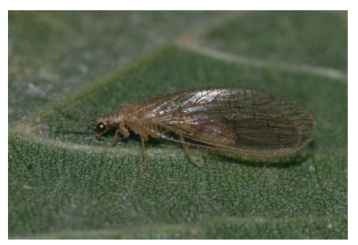
FIGURE 4 Adult of Nevrorthus from Italy (Nevrorthidae).
Adults are morphologically diverse and present few clearly defined synapomorphies, but the larvae of the six families share many defining morphological and biological characteristics. Primary among these are a head capsule with a highly sclerotized tentorium and a prementum that resembles a segment of the labial palp. Generally, myrmeleontiform larvae ambush, rather than pursue their prey, and the head capsules and jaws are modified to form a “trap”-like mechanism that can close very swiftly. Their long, robust, inwardly curved mandibles are frequently toothed mesally and constricted basally. The maxillae are lance-like, and the head capsule is robust, quadrate, or cordate (Fig. 6). The body form is short, broad, and powerful. The antennae are short and have only 10-12 segments, with a thick scape and a narrow distal portion. There are two tarsal claws and the empodium is absent (except from psychopsid larvae).
Within the Myrmeleontiformia, the Nymphidae, Myrmeleontidae, and Ascalaphidae form a relatively well-defined group, within which the Myrmeleontidae and Ascalaphidae are very closely related and appear to have a sister relationship. In fact, there are no unequivocal criteria for separating owlflies and antlions because most of the distinguishing traits are shared by some members of the other family. Nevertheless, in the vast majority of myrmeleontid and ascalaphid species throughout the world, adults and larvae exhibit the suite of characters that are typical of one family or the other; so, it is prudent to retain the two families until a thorough cladistic analysis is completed.
Opinions differ as to whether the Psychopsidae is the basal group of the Myrmeleontiformia or has a sister relationship with the Nemopteridae and Crocidae. Detailed studies of additional species from all three families may help resolve this issue.

FIGURE 5 Nevrorthidae: (A) larval body; (B) larval head.
The Psychopsidae is a small family of ~26 species within five genera. Adults are large, attractive, and moth-like insects (forew-ing length 10-35 mm). The family is restricted to Sub-Saharan Africa, Southeast Asia, and Australia. Historically, they were much more broadly distributed; fossils have been found in North America, Europe, Asia, and Australia.
Very little is known about psychopsid biology. Eggs are unstalked and attached to the substrate. They are laid singly or in groups on the bark of trees, and they are covered with a secretion that may be derived from plant material, but whose origin is unknown. Larvae of Australian species are found under loose bark (Fig. 6A). There are three instars and the life cycle may take two years. The cocoon has two layers of silk. Adults have been collected in river valleys.
Nemopteridae (Spoon-Winged or Ribbon-Winged Lacewings)
Until recently, this small family of ~100 species included species now comprising the Crocidae. Both groups are extraordinary looking lacewings that are easily distinguished by their remarkably elongate and narrow hindwings, and by a very short metathorax. Nevertheless,there are morphological and ecological differences between the two groups that are consistent with family status. Externally, nemopterid adults are distinguished from crocid adults by their large size (forew-ing length 13-35 mm) and hindwings that are ribbon-like, with or without dilation, but with distinct dark areas. Nemopterid larvae are myrmeleontid-like (Fig. 6B) . In contrast, adults of Crocidae have smaller bodies and their hindwings are thread-like (Fig. 1), white, and rarely with dark shading. Crocid larvae are very unusual, especially in the elongation and sclerotization of the cervix (Fig. 6C and 6D).
The Nemopteridae occurs in the arid and desert zones of the southern borders of the West Palearctic and West Oriental regions, and in dry areas of the Neotropical, Afrotropical, and Australian regions. The world’s richest nemopterid fauna is concentrated in southern Africa (>60% of the species). The fossil record indicates that this group was widespread and diverse in North America prior to the Oligocene.
Although nemopterid larvae have not been collected in ant nests, myrmecophily is strongly suspected. Nemopterid eggs are unstalked, small, spherical, or ovoid, and laid singly in the sand or soil. They have a micropyle and an oviruptor (an internal, toothed structure that tears open the chorion during hatching), but the surface of the chorion is smooth and seems to lack the aeropyles that are present
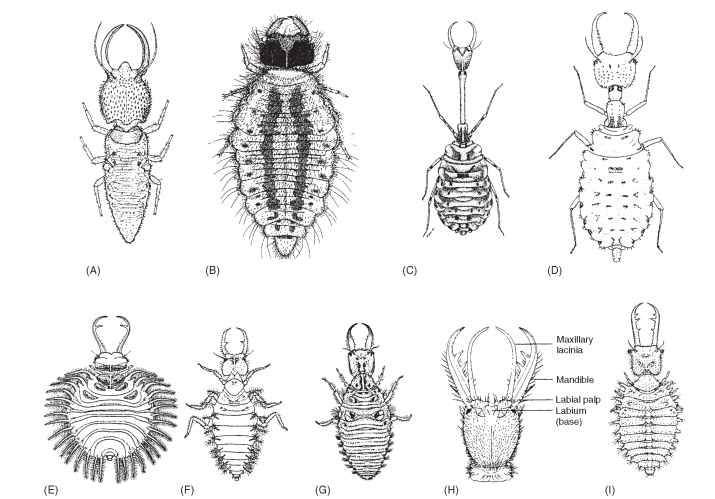
FIGURE 6 Myrmeleontiform larvae: (A) Psychopsidae; (B) Nemopteridae; (C) Crocidae; (D) Crocidae; (E) Nymphidae (Myiodactylinae); (F) Nymphidae (Nymphinae); (G) Myrmeleontidae; (H) Myrmeleontidae; (I) Ascalaphidae.
on crocid eggs. The eggs may be very hard and lack adhesives, and it is believed that they are introduced into ant colonies by foraging granivorous ants.
Apparently, the larvae avoid detection by ants through chemical mimicry and by attaching sand to their bodies. Young larvae may burrow into the sand. Mature third instars become very rotund and their movement is slow and ungainly. Ants appear to be the main food and it is thought that toxic materials are injected into prey, because prey becomes immobilized quickly after being attacked. Larvae can withstand long periods (up to several months) without food, and they require few prey items to complete their development. They may have very low rates of metabolism. Pupation occurs within a silken cocoon.
Adults are mostly crepuscular or nocturnal, and they feed on pollen. The modified hind wings appear to have defensive and sexual functions. For example, they provide camouflage and crypsis or give the illusion of greater size, and they may bear modified setae that have a role in courtship. Like myrmeleontid males, some nemopterid males also have membranous sacs (between tergites 5 and 6) that may emit pheromones. The elongated rostrum probably functions in collecting pollen and nectar. Adults occur during a brief period of the year, perhaps in synchrony with the ephemeral burst of flowers.
Crocidae (Thread-Winged Lacewings)
This small family of —50 species was traditionally included within the Nemopteridae (see above). The two families share elongate hind-wings, but crocids are distinguished by the thread-like hindwings, as well as several larval characteristics. The distribution of Crocidae overlaps that of the Nemopteridae: arid and desert zones on the southern borders of the West Palearctic and West Oriental regions and dry areas from the Neotropical, Afrotropical, and Australian regions. Crocid adults are medium to large-sized (forewing length 7-15 mm).
Crocid eggs differ markedly from those of nemopterids; both are unstalked, but crocid eggs have a sponge-like micropyle, the chorion has aeropyles, and no oviruptor is present. The larvae of some crocid species have exceptionally long cervical regions (Fig. 6C); these species are frequently associated with caves or dwellings. Species that have a shorter cervix usually live in detritus, under rocks or in crevices (Fig. 6D) . Crocid larvae are largely “sit and wait” predators; some species may pursue prey. In both cases, they can survive for long periods without food, but little is known of the larval diet. Pupation occurs within a silken cocoon that incorporates sand or debris externally. Adults are either crepuscular or diurnal, and they may feed on pollen and/or nectar. Apparently, the hindwings have sensory and stabilizing functions, which enable the lacewings to detect vertical and horizontal surfaces and to fly in confined spaces, such as caves. They may also function in attracting mates and during courtship.
Nymphidae (Split-Footed Lacewings)
This small neuropteran family is restricted to the Australian region (Australia, New Guinea, and nearby islands); it contains —35 species in seven genera. Currently the Nymphidae includes two well-defined lineages, the subfamilies Myiodactylinae and Nymphinae. Nymphid adults are large (forewing length 18 to >40mm). They may resemble myrmeleontids, but they have long, slender antennae.
Nymphid eggs are laid on slender, filamentous stalks. In Myiodactylinae, the stalks are either pendant or looped, so that the egg contacts the substrate. In Nymphinae, the eggs are arranged in intricate patterns (Fig. 7). In both subfamilies, the stalk may be
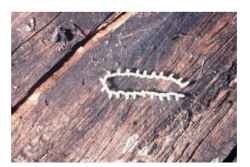
FIGURE 7 Eggs of Nymphidae laid under bark.
coated with beads of liquid that may serve nutritional and/or defensive functions. Myiodactyline larvae are very flat, and the margins of their bodies have long scoli (Fig. 6E); they are green and arboreal, and they rest on the surface of leaves with the jaws at an angle of —180°. Nymphine larvae (Fig. 6F) live in litter or on the bark of trees where they are camouflaged by the debris they carry or by the markings on the body. Cocoons probably are spun in sand. Adults of one species form large aggregations, but the function (e.g., mating, defense) of the aggregations is not known. Some species occur in association with acacias. Adults produce an odor from eversible abdominal glands and copulation involves enlarged and elaborate male terminalia that presumably have a grasping function.
Myrmeleontidae (Antlions, Doodlebugs)
With —2100 species in 300 genera, the antlions constitute the largest neuropteran family. Members of this family have intrigued naturalists from the earliest times; W. M. Wheeler provided imaginative accounts in his 1930 topic, Demons of the Dust. Most people know antlions because the larvae of some species have pit-building habits. In truth, both the name “antlion” and the assumption that all antlions construct pits are misleading; myrmeleontid larvae do not feed exclusively on ants and most do not construct pits. Adults are slender bodied and medium to large-sized (forewing length
10 – 70 mm).
Four subfamilies of Myrmeleontidae are generally recognized: Myrmeleoninae, Palparinae, Acanthaclisinae, and Stilbopteryginae (formerly a separate family, Stilbopterygidae). Larval morphological (Fig. 6G and 6H) and biological characteristics are crucial in the classification of the family, especially at the tribal level but also for many genera.
This family has a worldwide distribution, notably in the arid and semiarid areas of subtropical and tropical regions of Africa, Australia, Asia, and the Americas. Myrmeleontids inhabit open woodlands, scrub grasslands, and dry sandy areas. Efforts have been made in South Africa to assess the taxonomic richness of the large fauna and to help conserve it.
Myrmeleontid eggs are unstalked and relatively large; they are laid singly in open areas or tree holes, under bushes, in caves, under rock overhangings, or in areas sheltered by buildings. The eggs are covered with a glandular secretion that facilitates adhesion of sand or soil particles, and they lack an oviruptor.
The larvae of most species appear to be “sit and wait” predators. In most taxa they live beneath the soil surface, on trees, in tree holes, under stones, or in debris. Larvae in a very small number of genera construct pits in sand or soil that entrap prey. For a few species, the interactions of pit architecture, pit location, prey availability, and larval growth have been studied extensively.
The larvae of some myrmeleontid species can travel quickly over the surface of the sand; others have slow, creeping movements or fast backward movements under the sand. These behavioral patterns are aided by the forward-directed terminal segments (fused tibia-tarsus) of the hindlegs, and they have led to the common name, “doodlebugs.” Ingestion is accomplished by the injection of digestive enzymes from the midgut into the prey, followed, after several minutes, by sucking. The regurgitated gastric juice is not mixed with the contents of the crop or the midgut. Instead, it appears to be extruded from the space between the peritrophic membrane and the epithelium of the midgut; then contractions of the crop’s muscular system transport the fluid forward through a fold in the wall of the crop.
Larvae pass through three instars. In some species, larval development can be protracted over several years depending upon the availability of prey; overwintering occurs in the larval stage. Univoltine or semivoltine life cycles are influenced by photoperiodic and thermal responses during early and late larval stages; pupal size may also be important in determining the number of generations per year. Larvae generally spin a single-walled cocoon; a double-walled cocoon occurs in one unusual South American species.
Adults are largely nocturnal and presumed predacious. Their flight resembles that of damselflies. Sexual communication involves the extrusion of “hair pencils” and abdominal glands or sacs on the male (analogous to those found in lepidopteran males), as well as the release of volatile substances from thoracic glands in both males and females.
Ascalaphidae (Owlflies)
The owlflies constitute a medium-sized neuropteran family of — 430 species assigned to 65 genera. Adults are distinguished from myrmeleontid adults by their long, clubbed antennae. There are three subfamilies: one with bisected eyes (Ascalaphinae) and two with entire eyes: Haplogleniinae and Albardiinae. The subfamily Albardiinae consists of a single, very unusual, large-bodied Brazilian species.
The two major subfamilies (Ascalaphinae and Haplogleniinae) are widely distributed in the warm regions of the world, but the Haplogleniinae only occurs in Australia. Ascalaphids inhabit grasslands and warm dry woodlands. Most species are nocturnal or crepuscular, but some Eurasian species are diurnal and have pigmented wings that resemble those of butterflies. Adults are relatively large (forewing length 15-60 mm).
Clusters of 20 to 75 large, unstalked eggs are laid on twigs in spirals or rows. Individual eggs are reported to have two micropyles, but lack an oviruptor. Females of many species place small, modified eggs (repagula) on or around egg batches; these repagula reportedly have defensive and nutritional functions—)hey serve to divert or repel predators and/or provide food for newly hatched larvae. The two major subfamilies in the New World possess this habit, but it is absent from Old World and Australian ascalaphids.
Newly hatched larvae often remain together near the egg cluster for a week or more before dispersing. Larvae are either terrestrial (in the soil or litter) or arboreal (on leaves or tree trunks), and most appear to be “sit and wait” predators (Fig. 6I). Characteristically, the larvae hold their jaws open at very wide angles; some New World species resemble nymphids in being able to open their jaws beyond 270°. Larvae can take relatively large prey, and when a larva contacts prey, its jaws can close very rapidly. Considerable evidence shows that the larvae paralyze their prey with toxins from the midgut, not from glands. As with other myrmeleontiform larvae, there are three instars.
Larvae of some species that live in the soil or sand, camouflage themselves with sand grains or debris. Such behavior shares features with the “camouflaging” behavior of chrysopid larvae, but ascalaphid larvae use their flexible foretarsi, rather than the jaws, to place material on their dorsa. A thick mat of tangled threads anchors the debris to the dorsal surface.
Second and third instars resist starvation well, and development may extend to one or two years. Because ascalaphid adults occur at specific times of the year, diapause probably intervenes in some larval stages. Photoperiod or other factors may serve to regulate the occurrence of diapause, but the responses and mechanisms have not been studied. Pupation occurs within silken cocoons that are spun on the ground or on trees; sometimes they incorporate sand or debris.
Adults remain motionless in a characteristic head-downward position for most of the day; flight is restricted to a relatively short period around dusk and is preceded by — 10min of muscle-warming via wing vibration. Compared to other neuropterans, ascalaphids have strong and agile flight, similar to that of dragonflies. Adults feed on large numbers of flying insects (e.g., caddisfly adults); prey capture and mating occur on the wing.
SUBORDER HEMEROBIIFORMIA
The Hemerobiiformia contains ten well defined families with diverse life styles and physical structure (Fig. 8 ) . Its monophyly is open to question, and phylogenetic relationships among the families are largely unresolved. Studies of the larvae indicate that the members of the suborder share a number of distinguishing characteristics. For example, larval head capsules have the following synapomorphies: posteroventral region that is composed primarily of the maxillae, cardines that are elongate, and cervical regions that are cushion-like. Thus, monophyly of the Hemerobiiformia and its sister relationship with the Mymeleontiformia have some support. However, recent molecular and adult morphological data conflict with these conclusions. The new data are consistent with a sequence of evolutionary splitting events that yielded the Nevrorthidae, Sisyridae, and Osmylidae, respectively. The adult morphological data suggest that these events were followed by the separation of two lineages—one that includes the Coniopterygidae + the dilarid-like families and another encompassing the remainder of the hemerobii-form families + the Myrmeleontiformia.
Ithonidae and Polystoechotidae consistently appear as sister taxa within the Hemerobiiformia. The larvae of both of these families are unique among the Neuroptera in that they feed by sucking on plant tissues. Some authors give family status to Rapisma (Rapismatidae). However, the ithonid genus Adamsiana has adult morphological features that are intermediate between the Ithonidae and Rapisma, and we include both genera in the Ithonidae while awaiting discovery of the larvae and molecular analysis of the two genera.
Relationships among the remaining hemerobiiform families, all of which are carnivorous in the larval stages, are controversial. The dilarid lineage [Dilaridae, Mantispidae, and Berothidae (including Rhachiberothinae)] is strongly supported by larval and adult morphology, but contradicted by molecular data. According to the larval morphological data, the Chrysopidae and Osmylidae form a sister group, although the evidence for this relationship is not strong. A sister relationship between the Chrysopidae and Hemerobiidae is supported by both molecular data and adult morphology. Further comparative studies of these ancient holometabolous families are needed.
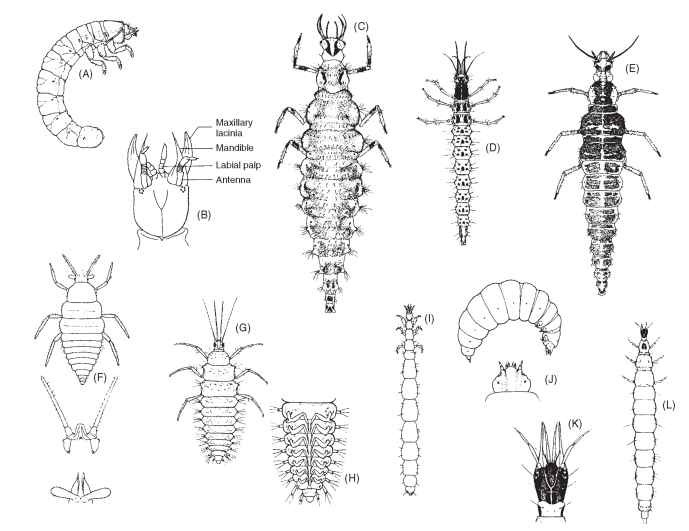
FIGURE 8 Hemerobiiform larvae: (A) Ithonidae; (B) Polystoechotidae; (C) Chrysopidae; (D) Osmylidae; (E) Hemerobiidae; (F) Coniopterygidae; (G) Sisyridae; (H) Sisyridae (venter of abdomen: note gills); (I) Dilaridae; (J) Mantispidae; (K) Berothidae; (L) Berothidae.
Ithonidae (Moth Lacewings)
This very small family includes —32 species in six genera: three from Australia, one from southeastern Asia, and two in the southwestern United States, Mexico, and Central America. Adults are large and moth-like (forewing length 15-30mm); they exhibit a variety of plesiomorphic, but few apomorphic characters. The larvae are subterranean and scarabaeiform: their abdomens are large and swollen, legs are short and fossorial, and the short mandibles curve inward and slightly upward (Fig. 8A). The maxillae are broad and robust; the mandibles are narrow. Eyes are absent.
Little is known about ithonid biology. Unstalked eggs are laid singly in the soil, where their sticky surface accumulates soil and sand particles. The larvae of one species in Australia are associated with the roots of Eucalyptus trees and a North American species occurs near creosote bushes. The specific food sources of these larvae (plant, mycorrhizae or other fungi, or associated herbivores) are not known. In one Australian species, five instars have been demonstrated, an unusual trait among neuropterans, which characteristically have three instars. Larval development may take two or more years; pupation occurs within silken cocoons in the soil. Apparently, mature larvae undergo diapause; adults emerge synchronously in large numbers, usually following a period of rainfall. Males emerge first and form aggregations that attract females; adults live for only a few days.
Polystoechotidae (Giant Lacewings)
The Polystoechotidae constitutes an extremely small family (4 species) of large-bodied lacewings with long wings (forewing length 15-40mm) (Fig. 9). The adults resemble ithonids, but polystoechotids are larger, their wing venation is more complex, and there are genital differences. This family is restricted to the New World.
Eggs are like those of ithonids: large, unstalked, and covered with sticky material. Only the first instar of Polystoechotes has been described. Unlike the scarabaeiform ithonid larvae, this larva is hemerobiid-like: it is elongate and has relatively long legs, a short multisegmented antenna, and robust jaws (Fig. 8B). Little is known
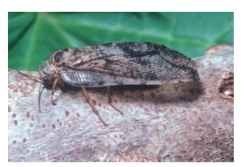
FIGURE 9 An adult of Platystoechotes from California (Polystoechotidae). These insects are rarely seen.
about polystoechotid biology; phytophagy is suspected but not confirmed. It is noteworthy that populations of one of the species in North America have declined greatly since the 1900s. Thus, lack of knowledge concerning this family is especially unfortunate.
Osmylidae
Osmylidae is a family of ~160 species in eight poorly defined subfamilies. Their systematics needs considerable reassessment.
Osmylids are slender, moderate-sized lacewings (forewing length 15-30mm), with broad pigmented wings. The family is distributed over much of the Old World; five subfamilies occur in Australia and two in South America. Osmylids have not been found in North America.
Knowledge of osmylid biology is sparse. Elongate, knobbed, unstalked eggs are laid with their sides attached to foliage. Larvae live under stones or at the water-l and interface near streams or under the loose bark of trees. Osmylid larvae have long slender stylets like those found in sisyrids (and berothids) (Fig. 8D – , but unlike sisyrids, they lack gills and breathe through thoracic and abdominal spiracles.
Sisyridae (Spongillaflies)
The Sisyridae constitutes a small, but cosmopolitan family that contains ~50 species in four genera: Climacia, which is restricted to the New World; Sisyra, which is cosmopolitan; and Sisyrina and Sisyrella, which are small Australian and Asian genera. It is the only hemerobiiform family with truly aquatic larvae. Sisyrid larvae are believed to feed exclusively on freshwater sponges, and they are unique among the Neuroptera in having segmented abdominal gills that function in breathing (Fig. 8H) . Adults are dull in color and relatively small (forewing length 4-10mm). They closely resemble brown lacewings, but the simple, open venation of the forewing and the branching pattern of the radial sector distinguish them.
The sessile eggs of sisyrids are laid singly or in groups on objects that overhang water. A flat layer of silk covers the eggs. Hatching is aided by an oviruptor, and subsequently the neonate larvae walk or drop to the water where they find and enter a sponge colony.
Sisyrid larvae probe sponges with their long, flexible mouthparts (Fig. 8G – . Although they have six Malphigian tubules, only one is attached distally to the rectum, a condition that is probably associated with the aquatic life style. After feeding and development, the mature larvae swim to the shore, attach to objects close to the water, and spin double-layered cocoons within which they pupate. Adults forage on nectar, pollen, algae, fungi, aphids, and mites.
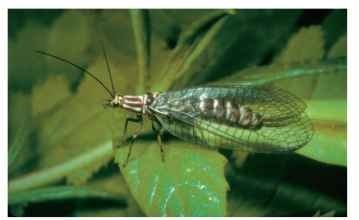
FIGURE 10 Despite their common name, green lacewings, adults of many species of Chrysopidae, such as this Nothochrysa adult, are darkly colored.
Chrysopidae (Green Lacewings)
Chrysopidae, with its ~1200 recognized species, is one of the two large families of Neuroptera, second only to the Myrmeleontidae. The larvae of many chrysopid species feed on insect and mite pests of agricultural crops or horticultural plantings, and because of their value in biological control, chrysopids are the most frequently studied of the Neuroptera.
Adults are medium-sized to large, delicate insects with four subequal wings (forewing length 6-35 mm) and relatively long, filiform antennae. In most species the adults are green with large golden eyes, but some species have black, brown, or reddish adults (Fig. 10). Larvae vary in shape and habits; some are voracious, active, and more-or-less generalist predators, with sleek, fusiform bodies (thus the name ” aphis-lions ” ) ( Fig. 8C ). Others are slow-moving, cryptic, trash-carrying predators with bulbous bodies, elaborate tubercles, and long, hooked setae; they are usually associated with specific types of ant-tended prey. Still others live in ant nests where they feed on the inhabitants; they have rotund, bulbous bodies, greatly shortened appendages, and a dense covering of stiff, hooked setae that hold protective trash on the body.
Currently, the Chrysopidae comprises three subfamilies (Nothochrysinae, Apochrysinae, and Chrysopinae); all three are only weakly supported by molecular data and only the first is well defined on the basis of adult and larval characters. Systematic and comparative biological studies are needed to clarify the taxonomy and phylo-genetic relationships of the chrysopid taxa and also to facilitate their use in biological control.
Given the wide range of morphological and behavioral variation among chrysopid larvae, it is clear that inclusion of all life stages is crucial for advancing the systematics of the family. Recent studies of previously unknown larvae have led to changes in the tribal assignments and the recognition of new Neotropical genera. However, except for the European and Japanese faunae where larvae of approximately 80% of the species are described, the world’s chrys-opid larvae are poorly known.
The Nothochrysinae includes only nine extant genera; it is believed to be the basal chrysopid lineage, but molecular data have not confirmed this opinion. Defining characteristics occur in the adult and larval stages; however, larvae from very few genera are known. Apochrysinae may be monophyletic, but more supporting data are needed. The larvae of one apochrysine species have been described, but distinguishing subfamilial traits were not apparent. The subfamily contains the largest and visually most spectacular green lacewings; its ~13 genera are based largely on somewhat variable characters in wing venation. Biological studies are needed.
The large subfamily Chrysopinae encompasses over 97% of the known chrysopid species; it includes ~60 genera distributed among four tribes, at least two of which are poorly defined and probably not monophyletic. The tribe Chrysopini is the largest and least well known; it contains almost all of the lacewings of economic importance.
As a group, the Chrysopidae is cosmopolitan; similarly, all of the subfamilies are widely distributed. Nevertheless, many of the genera have limited geographic distributions. For example, among the Apochrysinae, two genera occur only in Africa, four in the Neotropics, six in the Oriental region or Australia, and one in the eastern Palearctic. Most genera of Nothochrysinae are endemic to small geographic ranges; many species are known solely from a very few specimens. The genera within Chrysopinae range from cosmopolitan to narrowly endemic.
Typically, chrysopid eggs are laid at the end of long stalks, either singly, in groups, or in clusters with the stalks loosely or tightly intertwined. The egg stalks can be naked or they may bear oily droplets; the droplets contain nutrients or defensive substances that protect the egg or the newly hatched larva from natural enemies.
Larvae of some chrysopid species have fairly large prey ranges; they may feed on homopterans, lepidopteran eggs or larvae, and a variety of soft-bodied arthropods. But, contrary to popular lore, some species have evolved a very strong association with a particular type of prey. In Chrysopa, prey specialization can be restricted to a single species of prey and is based on a suite of intrinsic and extrinsic factors, including maternal oviposition behavior, egg size, larval morphology and behavior, phenotypic plasticity in life-history traits, responses to natural enemies that are associated with specific prey, and phenology. Studies indicate that prey association, such as that in Chrysopa, and also habitat association, as shown in Chrysoperla, can evolve in a manner that is very similar to the evolution of host specificity in phytophagous insects; there is good evidence that both can be involved in speciation.
Adults of most chrysopid genera feed on honeydew and pollen; in these lacewings, the dorsal crop diverticulum has numerous tracheae and is filled with symbiotic yeast. These symbiotes provide essential nutrients that are deficient in the diet. Adults in a few genera are predacious. In some species, adults emit foul-smelling defensive odors when they are disturbed.
Some chrysopid species are multivoltine, others are univoltine; most enter diapause and undergo dormancy (hibernation, aestivation) during unfavorable (e.g., cold, hot, or dry) seasons. The dia-pausing stage (free-living larva, prepupa, or adult) varies among lacewings and is a characteristic of the genus. Some chrysopids that diapause as adults undergo seasonal color changes that appear to reflect the background color of their habitat during the unfavorable season. Although lacewings are not considered especially strong flyers, they can move considerable distances with the wind. In species that diapause as adults, there is a seasonal pattern to movement between habitats. Photoperiod often provides very important cues for timing lacewing dormancy and seasonal movement; temperature, moisture, and food can also be significant factors. The genetic basis for lacewing responses to seasonal cues has been demonstrated; some exhibit geographical variability and epistasis.
Chrysopine lacewings have two modes of hearing. The “ear” (tympanal organ) is at the base of the radial vein in each forewing. It is the smallest tympanal organ known, and it receives the ultrasonic signals of insectivorous bats. Ultrasonic signals at low rates 50 pulses per second) cause the lacewing to cease flight and to fall. As the bat continues to approach, its signal increases in frequency; the high-frequency signal causes the lacewing to flip its wings open quickly and fly, thus aiding its escape. The second type of hearing, the perception of low-frequency, substrate-borne sounds that are emitted during courtship, is accomplished through scolopidial organs in the legs. Such sounds are an integral part of courtship in Chrysoperla species; variation in the production and perception of these sounds may have a role in speciation.
The endemic complex of green lacewings on the Hawaiian Islands, belonging to the genus Anomalochrysa, has evolved several unique characteristics and exhibits an extraordinary range of variation in morphology and behavior. For example, unlike any other known chrysopids, Anomalochrysa females lay sessile (unstalked) eggs, either singly or in batches. Larval body shapes range from fusiform with greatly reduced lateral tubercles and few, short setae, to flattened with well developed lateral tubercles and numerous, long, robust setae. In continental lineages, such broad variation is found only among genera. In some species, adults or larvae are very bright and colorful; in others they are dull or resemble bird feces. Males and females may produce conspicuously loud clicking sounds during courtship and mating; how these sounds are produced and perceived is unknown.
Some species in the genus Chrysoperla are mass-reared for release in the biological control of agricultural and horticultural pests. Among those in North America are Chrysoperla carnea (s.l.) and Chrysoperla rufilabris. These species possess characteristics that are advantageous for mass-rearing. For example, adults do not require prey, but will reproduce when fed artificial diets; they can be stored for long periods without significant loss of reproductive potential; and larvae can develop when fed artificial or factitious prey. Larvae of Ceraeochrysa species, which are trash-carriers, share many of the above traits that subserve mass production. They have the added advantage of being camouflaged and thus protected from their own natural enemies, for example, ants. The role of lacewings in pest management, whether naturally occurring or augmentative, is far from fully exploited.
Hemerobiidae (Brown Lacewings)
Hemerobiidae constitutes a cosmopolitan clade that is relatively well known and easily recognized. It is the third largest neurop-teran family, with ~550 species. Adults are generally small (forewing length 3-18 mm), brown, and inconspicuous. The ~27 extant genera of hemerobiids fall into ten reasonably well-defined subfamilies. The Carobiinae and Psychobiellinae each consist of one genus that is restricted to the Australian region. Each of the Hemerobiinae, Sympherobiinae, Notiobiellinae, and Microminae include three to five genera; all four of these subfamilies are cosmopolitan, but some of the small genera that they encompass have very restricted distributions. The Drepanacrinae and Drepanepteryginae each contain three genera with restricted distributions, and the Megalominae comprises one genus with broad distribution. The most recently described subfamily, Adelphohemerobiinae, consists of a single genus known only from South America.
Larval morphology may offer a rich suite of traits for phyloge-netic analysis; however, the larvae of only nine genera (from 7 of the 10 subfamilies) have been described. There are three instars. In the first instar, body setation is sparse, and trumpet-shaped empodia are present between the tarsal claws. Second and third instars are similar to each other except in size; they may have numerous short setae, and their empodia are short (Fig. 8E).
Mainly because the systematics of the family was neglected until recently, the life cycles of relatively few hemerobiid genera are known, and the groups that have been studied occur largely in the Northern Hemisphere. In general, hemerobiid eggs are sessile (unstalked) and laid singly or in clusters. Hatching is accomplished by means of an oviruptor.
Larvae prey upon a variety of small, soft-bodied arthropods and eggs. Little is known about the range of larval diet or its specificity, but some species have a strong association with a particular type of plant or habitat, and it is likely that some of these are also specific in their diets. Pupation occurs within thinly spun cocoons. Pupae have a peculiar set of hooks on the dorsum of the abdomen; their function is unknown. Most species seem to be predacious in the adult stage, but there are records of extensive honeydew feeding by adults. Life cycles range from univoltine to multivoltine, but for most taxa the overwintering stage is unknown.
Flightlessness has evolved several times in the Hemerobiidae; it is largely confined to species that occur on islands or are restricted to isolated mountains. In flightless forms, the hindwings are greatly reduced or absent, or the forewings are hardened or fused. Modifications associated with flightlessness are probably most extreme in the endemic Hawaiian Micromus. Pronounced sculpturing of the wings also occurs in winged (and flighted) endemic Hawaiian Micromus species ( Fig. 11 ).
Many species of Hemerobiidae may be important natural enemies of arthropod pests on agricultural and horticultural crops or in forests. Hemerobiids often are active at relatively low temperatures; thus they can be useful as biological control agents in temperate regions early in the season when other natural enemies remain inactive.
Coniopterygidae (Dustywings)
Because of their small size and cryptic nature, coniopterygids are generally overlooked and thus considered rare. However, with — 450 species, the Coniopterygidae constitutes a relatively large family and is one of the best-known systematically. Although they clearly belong within the Neuroptera, coniopterygids differ in a number of ways from other neuropteran families. Previously, they were considered the sole family of a separate primitive suborder (superfamily), the Coniopterygoidea. However, a recent cladistic analysis provides some evidence that the Coniopterygidae and Sisyridae may form a derived sister group within the Hemerobiiformia.
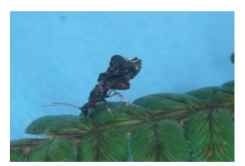
FIGURE 11 Hawaiian hemerobiid adult in the genus Micromus. Note the sculptured wings and their color resemble the curved edges of dead fern leaves, where this species often rests.
The Coniopterygidae is generally a very homogeneous family characterized by very small adults (forewing length 2-5 mm) with bodies covered by white waxy (“dusty”) secretions (Fig. 12). The secretions originate from hypodermal wax glands on the sternites and tergites of the abdomen and are spread over the body by the hindlegs. Other than in the coniopterygids, such glands are only found in the homopterans Aleurodina and Coccina. This similarity represents a remarkable example of convergent evolution especially because coni-opterygids frequently are associated with these waxy homopterans.
Currently, the Coniopterygidae contains three well-defined, probably monophyletic subfamilies: Coniopteryginae, Aleuropteryginae, and Brucheiserinae. Both the Coniopteryginae and the Aleurop-teryginae are large groups with cosmopolitan distributions. The Brucheiserinae differs from the other two subfamilies in having highly unusual reticulate wing venation. Brucheiserinae is known only from the neotropics and its larvae are not described. Some authors have considered it a separate family (Brucheiseridae), but this distinction is probably not justified. In this regard, discovery of the larvae may be very valuable.
The life histories of very few coniopterygid species are known. Both larvae and adults occur on trees and bushes (sometimes on low vegetation). Many species appear to be associated with specific types of vegetation, and this habit may indicate prey specialization. Eggs are unstalked and laid near prey; there are three instars (Fig. 8F).
Adults and larvae prey on small, soft-bodied arthropods (aphids, scales, mites); adults may also feed on honeydew and perhaps pollen. Flat cocoons with double walls are spun on foliage or tree trunks. Adults are usually active at dusk or at night. Life cycles and overwintering stages vary (prepupae within cocoons, free-living second instars) and have not been well studied.
Many species of coniopterygids are considered to be important natural biological control agents; unfortunately, their role has not been evaluated and their potential remains undeveloped.
Dilaridae (Pleasing Lacewings)
This small family of —50 species has well-defined affinities with the Berothidae and Mantispidae. It contains two subfamilies: Dilarinae, which is confined to the Old World, and Nallachiinae, which occurs in the New World (with one species known from South Africa). It is one of the few neuropteran families absent from the Australian region.
Adults resemble small, delicate hemerobiids (forewing length 3-16mm in males and 5-22mm in females). But, they are differentiated by ocelli-like tubercles on the head of both sexes (functional
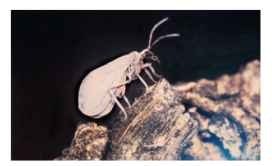
FIGURE 12 Adult of Coniopteryx from Switzerland (Coniopterygidae); note the powdery, white wings.
ocelli are absent), a long ovipositor in females, and pectinate antennae in males.
Dilarid eggs are elongate and unstalked. Those of Nallachus are laid in association with dead trees. The larvae of Nallachus inhabit the galleries of insects in decaying logs or the area beneath the tightly adhering bark of erect, recently dead trees (Fig. 8I). Larvae of Dilar have been found in the soil, but their larval diet is not known.
Development probably takes one year. Larvae may undergo supranumerary molts: that is, if undernourished, they may continue to molt as many as 12 times. However, those that did so under laboratory conditions did not metamorphose successfully.
Mantispidae (Mantidflies)
With ~400 species, Mantispidae is the largest family in the dilarid lineage (Dilaridae, Berothidae, Mantispidae). These moderate to large-sized lacewings (forewing length 5-30 mm) are recognized by raptorial forelegs that resemble those of mantids. Their simple, sub-equal wings are narrow and elongate, and they have a distinct ptero-stigma and chrysopid-like venation. Larvae are similar to those of the Berothidae in that they are hypermetamorphic; however, in the case of the mantispids the first instars are campodeiform and the second and third instars are grub-like (Fig. 8J). The mantispids differ from the Rhachiberothinae in their wing venation, terminalia, and larval characteristics, but they are of similar body-size and also have raptorial forelegs.
The family contains four, apparently monophyletic subfamilies: Symphrasinae, Drepanicinae, Calomantispinae, and Mantispinae. Symphrasinae encompasses a large, diverse assemblage of species that occur from South America through southern North America. Drepanicinae is a smaller subfamily that occurs in restricted areas within South America and mainland Australia. Calomantispinae, another small subfamily, also has a disjunct distribution: eastern Australia (including Tasmania), and southern North America. Finally, the large subfamily Mantispinae ranges between 50°N and 45°S throughout much of the world. The biology and immatures of Drepanicinae and Calomantispinae remain largely unknown, whereas those of several genera in Symphrasinae and Mantispinae have been studied.
Larvae in the subfamily Mantispinae usually inhabit the egg sacs of spiders where they feed upon the contents, although some may be subterranean predators or possibly generalist predators. Numerous (200-2000) stalked eggs are laid randomly (and sometimes in clusters) on leaves and other substrates.
The newly hatched campodeiform larvae find their hosts (spider eggs) via one of two methods. Either, they actively seek a previously constructed spider egg sac that they enter through direct penetration, or they climb onto a female spider and enter the egg sac during construction. Those that board spiders can feed on the hemolymph of their host, but they do not molt until they enter an egg sac. If the campodeiform larva attaches to a male spider, it may transfer to a female during copulation. After finding an egg sac, the larva feeds on the contents (predation) and undergoes hypermetamorphosis.
The mature larva spins a cocoon within the spider egg sac, and pupation occurs within the larval skin; thus, to emerge, the mature pupa cuts its way through its larval exoskeleton, the cocoon, and the egg sac. Adults are predacious and they are active during the day or night. Overwintering in some species occurs in the first instar, and there may be one to more generations per year.
Several species within the Symphrasinae have been reared from nests of aculeate Hymenoptera or in the laboratory on larvae or pupae of Lepidoptera, Coleoptera, and Diptera. First instars may find their hosts by attaching to an adult bee or wasp and moving into a cell when the egg is laid. Subsequently, they feed on a single host (parasitism) to which they adhere via a sticky, yellow secretion; they have the typical mantispid hypermetamorphosis.
Adult Climaciella can be highly polymorphic, with each of several morphs mimicking a different species of polistine wasp. The proportion of the different morphs may vary depending on the number and aggressiveness of the various wasp species at each locality.
The larval habits of the Drepanicinae are unknown; Calomantispine larvae may be generalist predators.
Berothidae (Beaded Lacewings)
The Berothidae is a small family of ~115 species in four more-or-less distinct subfamilies: Rhachiberothinae, Berothinae, Nosybinae, and Cyrenoberothinae. Adults typically are small to medium-sized (forewing length 6-15mm) lacewings with brown wings and bodies. Frequently, the outer margin of the forewing is deeply incised (Fig. 13). Larvae are associated with termite nests. The family is cosmopolitan and occurs predominantly in warm temperate, tropical, and subtropical areas; the group is most speciose in Africa.
One subfamily of berothids, the Rhachiberothinae, differs considerably from the others. Its adults have raptorial forelegs that are very similar to those of mantispids. As a result, some authors consider them to be a separate family. However, because of the close similarity between the few known larvae in the two groups, we treat the Rhachiberothinae as a specialized subfamily of the Berothidae, while awaiting further study.
Eggs of three subfamilies are laid in clusters attached to one or several long, silken stalks; those of the fourth subfamily, Rhachi-berothinae, are sessile. Little is known of the subsequent life history, except for the North American genus Lomamyia (Berothinae). Their eggs are laid on dead trees or logs that contain colonies of subterranean termites, with which their larvae (Fig. 8K and 8L) are associated. First instars are mobile and after entering the termite colony they feed and molt. The second instar does not feed, but hangs immobile from the roof of the termite tunnel. Third instars resume feeding on termites. They subdue their prey with an allomone that is emitted from the tip of the abdomen and/or a neurotoxin that is injected through the mouthparts. Pupation occurs within silken cocoons that are spun in the termite nest. Adults are primarily nocturnal. As many as three generations can occur per year; the prepu-pal stage overwinters.
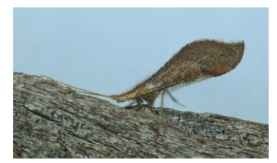
FIGURE 13 Adult of Podallea from Namibia (Berothidae); note the deeply scalloped wings.
